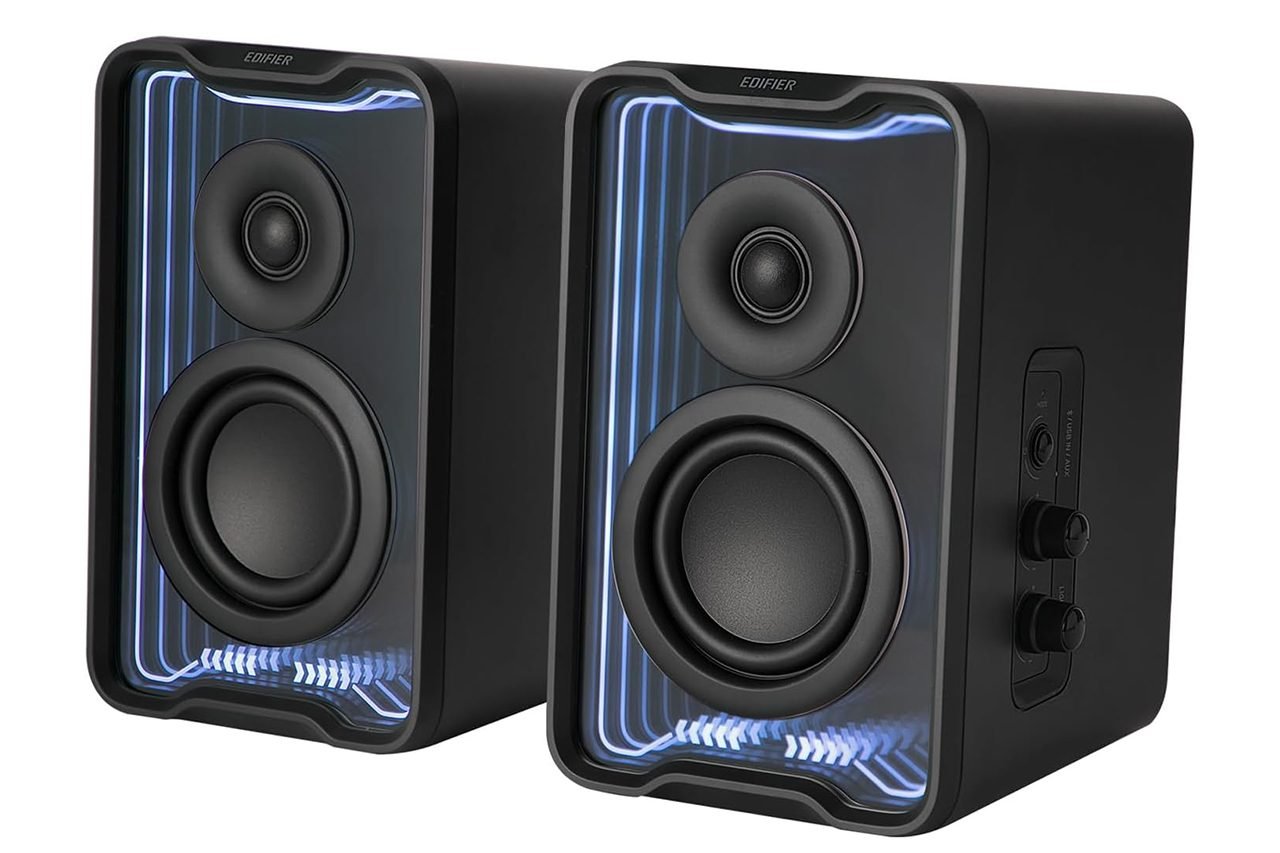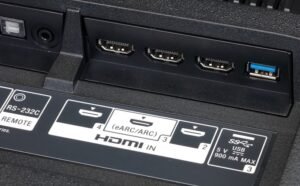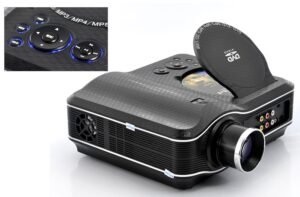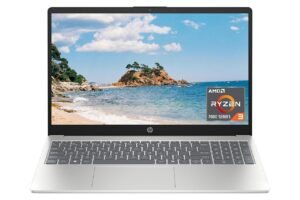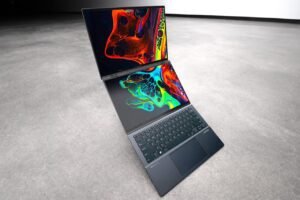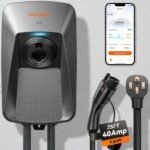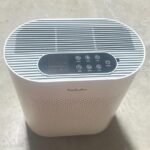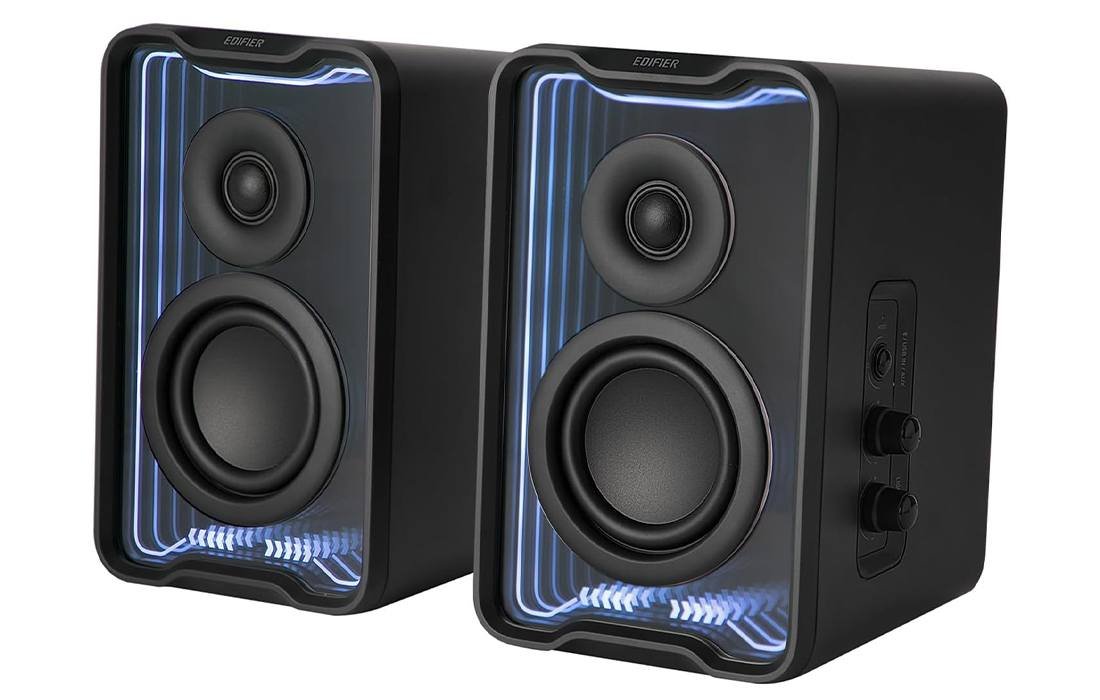
Edifier QR30 2.0 Desktop Active Speaker — Compact, Clean Sound for Modern Desks
Our take: a tidy, great-sounding 2.0 set with multipoint Bluetooth, customizable lights, and simple side-knob controls—perfect for near-field listening.
- 30W RMS Class-D power with 2.75″ mid-bass + 0.75″ silk-dome tweeter for clear, punchy near-field sound.
- Bluetooth 5.4 multipoint plus USB-A and 3.5 mm AUX for fast switching across phone, PC, and console.
- TempoAbyss light effects (12 presets) and app EQ via Edifier ConneX (mobile) or TempoHub (PC).
- Total Power
- 30W RMS (15W+15W)
- Connectivity
- Bluetooth 5.4 • USB-A • 3.5mm AUX
- Drivers
- 2.75″ Mid-bass • 0.75″ Silk Tweeter
- Size (per cab.)
- ~5.0″W × 7.6″H × 5.6″D
The Edifier QR30 is a compact 2.0 desktop speaker set that aims to be more than just “sound for your screen.” It blends a small footprint with punchy drivers, Bluetooth 5.4 with multipoint, hands-on side controls, USB-A and 3.5 mm inputs, and a ring-style lighting system you can actually tune from an app. On paper, it looks like a clean, fuss-free upgrade for desks where space is tight but expectations for clarity, bass weight, and overall polish are not.
I’ve been running the QR30 on a work-and-play desk setup: a 27-inch monitor, a laptop dock, and two sources connected at once (Bluetooth for my phone and USB for my PC). Over two weeks of daily listening—Spotify, YouTube, Premiere/DaVinci edits, gaming in the evenings—the pair’s character came into focus: lively, tidy, and surprisingly full given their size.
At roughly 4.41″ (W) × 7.60″ (H) × 5.59″ (D) per cabinet and 30 W RMS total from a Class-D amplifier, these are the sort of speakers you can park on a shallow shelf or under a low monitor arm. Inside each cabinet you’ll find a 2.75″ long-throw mid-bass driver and a 0.75″ silk-dome tweeter, supported by a rear port and tuned for a 63 Hz–20 kHz frequency response. That, plus a simple three-knob interface on the right cabinet—Mode, Volume/Play-Pause, and Light Effects—makes them welcoming right away.
Is the Edifier QR30 for You?
The need it solves: You want a tidy, modern 2.0 speaker system that’s effortless to live with: instant source switching (including multipoint Bluetooth), simple wired fallbacks (USB-A and AUX), physical controls on the speaker, and lighting you can shut off entirely or style to taste. You don’t want to fuss with an external DAC/amp stack or run a separate sub.
Who it’s for:
- Desk users who value clear vocals, crisp treble, and coherent stereo imaging more than shake-the-walls bass.
- Creators and students who jump between laptop, phone, and console and don’t want to re-pair devices all day.
- Minimalists who prefer compact gear that’s tasteful on a clean desk, with lighting that can match or disappear.
Who it’s not for:
- Bass maximalists and home-theater users who expect sub-80 Hz slam or true room-filling sound. (Physics is physics: a 2.75″ woofer can’t break the rules.)
- Audiophiles who demand higher-bit-rate Bluetooth codecs (no aptX/LDAC here; Bluetooth uses SBC).
- Users who insist on USB-C everything—the QR30 uses USB-A for its digital input.
Budget positioning: Squarely mid-tier for compact desktop speakers. You can pay less for basic 2.0 plastic boxes, but you’ll give up build, tuning, multipoint, and app-based control. You can pay more for studio monitors or 2.1 kits; those will be larger and fussier.
Beginner-friendly? Yes. Setup is drop-in: plug the power, link the passive speaker, pick your input, and you’re listening. The knobs make everything obvious.
What We Like About the Edifier QR30
What struck me first is the clean midrange. Podcasts and dialog-heavy videos sound natural and intelligible; singers sit forward without turning sharp or nasal. The silk-dome tweeter shows poise: cymbals have sheen rather than splash, while acoustic guitars carry string texture but not glassiness. There’s a deliberate voicing here that favors clarity over bright “wow.” After three hours of work calls, I wasn’t fatigued.
The little 2.75″ long-throw mid-bass driver does honest work. You’re not getting subwoofer rumble, but there’s enough body for pop, lo-fi, and most rock. Kick drums land with definition, not flab; bass guitars are easy to follow down to their mid-bass fundamentals. Movie trailers retain impact, and game soundtracks keep momentum. The rear port is well-managed—close to a wall it adds a touch of warmth without chuffing.
Bluetooth 5.4 multipoint is the daily quality-of-life win. My phone pings for a call; audio switches over immediately. Hang up, and the PC stream resumes. In practice, it eliminated the friction that usually makes me disable Bluetooth on desktop speakers. Wired USB-A is plug-and-play on Windows—no driver hunting—and 3.5 mm AUX is there for consoles, DACs, or a turntable with an external preamp.
The three-knob control cluster is underrated. I loved being able to press the volume knob to play/pause, long-press the Mode knob to power down, and sweep the Light Effects knob to dim or cycle effects. Add the Edifier ConneX (mobile) and TempoHub (PC) apps and you get EQ and sound-mode control (Music/Movie/Game) plus custom lighting (12 presets via TempoAbyss tech). The lighting is tastefully diffused—more ambient trim than gamer billboard—and can be turned off fully.
Finally, the industrial design feels cohesive. The stepped baffle and silver frame give the speakers shape without gimmickry. They look like they belong next to a monitor, not like a shrunken soundbar.
What We Don’t Like About the Edifier QR30
The QR30’s biggest compromise is deep-bass authority. Physics limits small woofers. You’ll hear solid punch from ~80–90 Hz up, but movie LFE and EDM sub-bass don’t arrive with the weight a larger 2.0 set—or a 2.1 kit—can summon. If you sit farther than arm’s-length from the speakers, the shortfall becomes more obvious.
Codec support is SBC only over Bluetooth. It’s fine for casual and even most focused listening if your source chain is decent, but if you crave the extra headroom and lower latency of aptX Adaptive or LDAC, you won’t find it here. Wired USB or AUX will still outclass typical Bluetooth streams for critical listening.
USB-A input, while convenient and stable, looks dated beside modern USB-C-centric desks. Functionally it’s a non-issue (adapters exist), but some users expect C ports everywhere. Also note the SNR spec (≥85 dB): the QR30 is quiet at idle on my desk, but if your PC’s USB power is noisy you may prefer AUX.
Lastly, there’s no dedicated subwoofer out. If you upgrade to deeper bass later, you’ll be moving to a new system, not adding a sub to this one.
Pros & Cons
| Pros | Cons |
|---|---|
| Clean, articulate mids and smooth treble for voices and acoustic instruments | Limited deep-bass output; physics of 2.75″ drivers |
| Compact footprint with tasteful, fully dimmable lighting | Bluetooth uses SBC only (no aptX/LDAC) |
| Multipoint Bluetooth 5.4 makes dual-device life painless | USB-A digital input (no USB-C) |
| Simple side-mounted knobs for power/mode, play/pause & volume, lighting | No sub-out for future bass upgrades |
| App control for EQ, lighting, and sound modes (Music/Movie/Game) | Best performance is near-field; loses body across a larger room |
| Solid build and modern design that complements a clean desk |
What’s Included?
- QR30 speaker pair (active + passive)
- Power cable × 1
- USB-A to USB-A audio cable × 1
- Quick start guide × 1
- Important safety instructions × 1
I’m happy with the out-of-box bundle for a compact 2.0 set. The USB-A cable works day one for PC users; AUX is easy to add if you need it. The only nice-to-have would be a short AUX cable in the box for plug-and-play with handhelds or consoles.
Technical Specifications
| Category | Spec |
|---|---|
| System type | 2.0 desktop active speakers |
| Total power (RMS) | 30 W (15 W + 15 W, Class-D amplifier) |
| Drivers | 2.75″ long-throw mid-bass, 0.75″ silk-dome tweeter |
| Frequency response | 63 Hz – 20 kHz |
| Signal-to-noise ratio | ≥ 85 dB (A-weighted) |
| Bluetooth | v5.4, multipoint (two devices) |
| Codecs | SBC |
| Wired inputs | USB-A, 3.5 mm AUX |
| Controls | Side-mounted Mode, Volume/Play-Pause, Light Effects knobs |
| Lighting | TempoAbyss system, 12 presets, adjustable brightness |
| Dimensions (Active) | 5.02″ (W) × 7.60″ (H) × 5.59″ (D) |
| Dimensions (Passive) | 4.41″ (W) × 7.60″ (H) × 5.59″ (D) |
| Net weight | ≈ 6.81 lb (pair) |
| Color | Black, White |
| Water resistance | Not water resistant |
| Typical range | ~10 m (Bluetooth) |
| Supported uses | Music, movies, gaming; desktop and small rooms |
Features
- Compact, modern industrial design that fits under monitors and on narrow shelves without looking toy-like.
- Bluetooth 5.4 with multipoint for dual simultaneous connections and quick switching.
- USB-A digital input and 3.5 mm AUX analog input for flexible wired setups.
- 2.75″ long-throw mid-bass + 0.75″ silk-dome tweeter combination for full-range near-field listening.
- Class-D amplification totaling 30 W RMS for efficient drive and low heat.
- TempoAbyss lighting with 12 preset effects; Light Effects knob adjusts mode and brightness.
- App support (Edifier ConneX mobile, TempoHub PC) for playback control, sound mode switch, and EQ customization.
- Physical controls: power/mode switching, play/pause via the volume knob, and lighting adjustments at your fingertips.
- Three preset sound modes—Music, Movie, Game—plus custom EQ to tailor tonality.
- Rear-ported cabinets tuned for punchy mid-bass without obvious port noise in near-field use.
Feature verdict: The QR30 hits the right conveniences for a modern desk. Multipoint Bluetooth and app-level tuning genuinely change daily behavior—you actually use the wireless path because it’s painless, and you actually nudge EQ because it’s a slider away. The lighting is a cherry on top: cool when you want it, invisible when you don’t. The only spec that feels dated is USB-A, though functionally it’s stable and simple.
Real-World Performance
Setup & placement. With the passive speaker linked and the active speaker powered, I started at arm’s length, tweeters just under ear height, speakers angled in about 20°. Near-field placement matters here; at 70–90 cm listening distance, tonal balance tightens and imaging pops into place. Slide them wider than your monitor’s edges if you can—they image better with a bit of breathing room.
Tonal balance. The QR30 is voiced clean, slightly warm in the lower mids, and polite up top. Vocals are clear without sibilance; piano has weight; strings are airy rather than etched. If you prefer a brighter presentation, bump the upper treble in the app; for EDM, a +2 to +3 dB shelf around 80–120 Hz adds fun without boom.
Bass behavior. Expect convincing mid-bass punch on kicks and toms; you’ll feel rhythmic drive in rock and pop. Below ~70 Hz the output rolls off; movie rumbles and the deepest synths are hinted, not delivered. In small rooms, a back-wall placement (10–15 cm) helped add body without obvious port chuff at moderate volumes.
Dynamics & loudness. For a 2.0 system this size, the QR30 gets respectably loud for near-field listening. The amp keeps control at desk volumes; at the very top of the dial you’ll hear compression before distortion—a sane engineering choice.
Imaging & stage. Edifier’s stepped baffle and driver alignment pay off. Pan effects move smoothly; dual-mic YouTube content has “in-the-room” presence; indie acoustic tracks feel anchored center with real left/right space. They behave like small monitors more than like bloated multimedia speakers.
Movies & games. The Movie mode tightens dialog and adds a tasteful low-end lift; it’s easy to follow speech even at low night-time volumes. Game mode nudges footstep cues forward and opens the top a hair; positional audio is clear. I still preferred Music + a mild custom EQ for most content.
Wireless vs wired. USB-A sounded a shade cleaner than Bluetooth SBC on dense material, with better micro-detail and stereo precision. Bluetooth remained perfectly usable for casual listening and calls; multipoint made it my default for phone audio regardless.
Noise & quirks. Idle hiss was inaudible at my seated distance. No pops switching sources. One small ask: an auto-standby toggle in the app would be handy for those who want aggressive power saving or, conversely, always-on behavior.
Comparisons (Desk-Sized 2.0)
- Cheaper plastic 2.0 sets offer more aggressive bass boost but smear the midrange and fatigue quickly at volume. The QR30 is cleaner, better built, and more coherent.
- Studio monitors (even small 3-inch models) deliver truer bass extension and headroom, but you’ll give up Bluetooth multipoint, lighting, and easy app EQ—they’re “work” speakers, not living-with-them speakers.
- 2.1 kits add real sub-bass but cost more desk/under-desk space, add clutter, and often lose the QR30’s midrange refinement.
Tips to Get the Best Sound
- Toe-in and symmetry: Aim the tweeters at your ears; keep both speakers the same distance from your seated position.
- Mind the wall: Start 10–15 cm from the back wall. Too close can blur; too far can thin out the mid-bass.
- Use the app EQ sparingly: A small bass shelf (+2 dB at ~100 Hz) and tiny treble lift (+1–2 dB >8 kHz) can tailor the sound without killing balance.
- Kill the lights (if you want): If visual distraction bugs you, dim or disable the lighting in one click—sound stays the same.
The Bottom Line
The Edifier QR30 earns its keep by nailing the everyday details that make small desktop speakers feel “grown up.”
You get clear mids, smooth highs, honest, punchy mid-bass, and the conveniences modern desks demand—multipoint Bluetooth, simple wired fallbacks, physical controls that make sense, and apps that are useful rather than gimmicky. Add styling that looks at home next to a monitor, and you’ve got a compact 2.0 system that behaves like a polished tool instead of a toy.
You can absolutely spend more to get deeper bass or studio-grade neutrality; you can also spend less and end up with shouty treble and boomy boxes. The QR30 sits in the sweet spot for most desks: pleasant, practical, and easy to recommend—as long as you understand you’re buying finesse and convenience, not floor-standing physics.
Final Breakdown
| Preview | Product | Price | |
|---|---|---|---|
|
|
Edifier QR30 2.0 Desktop Active Speaker, Compact Bluetooth V5.4 Computer Speakers, Wireless… |
$169.99
$129.99 |
View on Amazon |
9.1 / 10
The QR30 scores high for clarity, usability, and design. It loses points on deep-bass reach and Bluetooth codec options, and a USB-C port would modernize the spec sheet.
But judged as a compact 2.0 desk system, it’s a standout: set-and-forget convenience with a sound signature you can listen to all day.
If you want a small speaker that looks sharp, keeps your workflow fluid, and treats voices and instruments with respect, the Edifier QR30 belongs on your shortlist.


